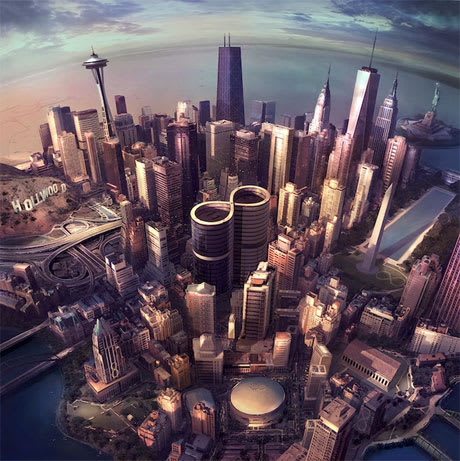Dave Grohl's unbridled enthusiasm for the magic and the power of rock'n'roll is a wondrous and thoroughly infectious thing to behold. It was there as he gleefully pounded the hell out of his drum kit in Nirvana, and it can make a stadium full of Foo Fighters fans feel like each and every one of them is Grohl's BFF. Lately, that energy has served Grohl's foray into roc doc filmmaking: Both Sound City and the first few episodes of his HBO show/recording project, Sonic Highways, have given viewers remarkable insight into the recording process and the people who make that happen.
With Sonic Highways in particular, Grohl has given a selective history of the music havens in a handful of American cities — and in the process has attempted to canonize some of the country's lesser-known, but no less important, studios — by rerecording a song in each of eight different locales, such as Steve Albini's Electrical Audio (Chicago), hardcore haven Inner Ear Studio (in Arlington VA), and the very place where Foo Fighters were born — Robert Lang Studio in Seattle.
The downside of all this rock'n'roll reverence, at least for the music of Sonic Highways, is it sounds like an album made by music fanboys, rather than the work of a band at the peak of their creative powers. The songs are all carefully crafted — simple hooks married with elaborate arrangements — and everything is exquisitely produced to capture that "warm sounding" organic sound you'd expect from a recording project devoted to recording studios. But the overwhelming vibe here is little more than: Yes, this is rock music!
Tunes like "What Did I Do/God as My Witness" and the overwrought "I Am A River" are amped-up MOR jams that evoke '70s rock excess without necessarily sounding retro. Even the highlights, like the "Monkeywrench" throwback "The Feast and the Famine" or the hard-charging "Outside," with its lengthy Joe Walsh–featuring jam, don't quite live up to the promise of their big riffs and punchy production — they're barely generic Foo Fighters songs.
For all its flaws, at least 2011's Wasting Light seemed to have a palpable urgency and a musical purpose — recapturing a bit of the energy from the glory days of The Colour and the Shape. Sonic Highways is an attempt to channel a different musical energy, but it's one that Grohl does a far better job capturing with his camera crew.
(Sony)With Sonic Highways in particular, Grohl has given a selective history of the music havens in a handful of American cities — and in the process has attempted to canonize some of the country's lesser-known, but no less important, studios — by rerecording a song in each of eight different locales, such as Steve Albini's Electrical Audio (Chicago), hardcore haven Inner Ear Studio (in Arlington VA), and the very place where Foo Fighters were born — Robert Lang Studio in Seattle.
The downside of all this rock'n'roll reverence, at least for the music of Sonic Highways, is it sounds like an album made by music fanboys, rather than the work of a band at the peak of their creative powers. The songs are all carefully crafted — simple hooks married with elaborate arrangements — and everything is exquisitely produced to capture that "warm sounding" organic sound you'd expect from a recording project devoted to recording studios. But the overwhelming vibe here is little more than: Yes, this is rock music!
Tunes like "What Did I Do/God as My Witness" and the overwrought "I Am A River" are amped-up MOR jams that evoke '70s rock excess without necessarily sounding retro. Even the highlights, like the "Monkeywrench" throwback "The Feast and the Famine" or the hard-charging "Outside," with its lengthy Joe Walsh–featuring jam, don't quite live up to the promise of their big riffs and punchy production — they're barely generic Foo Fighters songs.
For all its flaws, at least 2011's Wasting Light seemed to have a palpable urgency and a musical purpose — recapturing a bit of the energy from the glory days of The Colour and the Shape. Sonic Highways is an attempt to channel a different musical energy, but it's one that Grohl does a far better job capturing with his camera crew.
